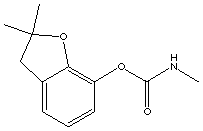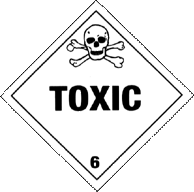Carbofuran
- 2,3-Dihydro-2,2-dimethylbenzofuran-7-yl methylcarbamate
- 2,3-Dihydro-2,2-dimethyl-7-benzofuranyl methylcarbamate
- 2,2-Dimethyl-2,3-dihydro-7-Benzofuranyl-n-methylcarbamate

Carbofuran | |
| |
| Formula | C12H15NO3 |
| Structure |  |
| Description | Carbofuran is a white, odorless solid dissolved in a liquid carrier. |
| Uses | Broad spectrum insecticide, nematocide. |
| Registry Numbers and Inventories. | |
| CAS | 1563-66-2 |
| EC (EINECS/ELINCS) | 216-353-0 |
| EC Index Number | 006-026-00-9 |
| EC Class | Very toxic; Dangerous for the Environment |
| RTECS | FB9450000 |
| RTECS class | Agricultural Chemical and Pesticide; Mutagen; Reproductive Effector; Human Data |
| UN (DOT) | 2757 |
| Merck | 12,1851 |
| Beilstein/Gmelin | 1428746 |
| Beilstein Reference | 5-17-04-00048 |
| RCRA | P127 |
| EPA OPP | 90601 |
| Swiss Giftliste 1 | G-5400 |
| Canada DSL/NDSL | NDSL |
| US TSCA | Listed |
| Austrailia AICS | Listed |
| New Zealand | Listed |
| Japan ENCS (MITI) | Listed |
| Korea ECL | Listed |
| Properties. | |
| Formula | C12H15NO3 |
| Formula mass | 221.26 |
| Boiling point, °C | 313 |
| Vapor pressure, mmHg | 0.0005 (25 C) |
| Vapor density (air=1) | 1.18 |
| Density | 1.18 g/cm3 (20 C) |
| Solubility in water | 0.07 g / 100 ml |
| pKa/pKb | 11.90 pKa) |
| Partition coefficient, pKow | 2.32 |
| Heat of vaporization | 55.4 kJ/mol |
| Hazards and Protection. | |
| Storage | Tightly closed containers. Keep away from heat and water. |
| Handling | All chemicals should be considered hazardous. Avoid direct physical contact. Use appropriate, approved safety equipment. Untrained individuals should not handle this chemical or its container. Handling should occur in a chemical fume hood. |
| Protection | Wear appropriate chemical protective clothing. |
| Respirators | Wear positive pressure self-contained breathing apparatus. |
| Small spills/leaks | Keep sparks, flames, and other sources of ignition away. Keep material out of water sources and sewers. Build dikes to contain flow as necessary. Attempt to stop leak if without undue personnel hazard. Use water spray to knock-down vapors. Land spill: Dig a pit, pond, lagoon, holding area to contain liquid or solid material. Cover solids with a plastic sheet to prevent dissolving in rain or fire fighting water. Water spill: Use natural deep water pockets, excavated lagoons, or sand bag barriers to trap material at bottom. If dissolved, in region of 10 ppm or greater concentration, apply activated carbon at ten times the spilled amount. Use mechanical dredges or lifts to remove immobilized masses of pollutants and precipitates. |
| Stability | Stable under neutral or acid conditions, unstable in alkaline media. |
| Incompatibilities | Incompatible with strong acids and bases, and especially |
| Fire. | ||||
| Flash Point,°C | 143 | |||
| Fire fighting | Do not extinguish fire unless flow can be stopped. Use water in flooding quantities as fog. Cool all affected containers with flooding quantities of water. Apply water from as far a distance as possible. Solid streams of water may be ineffective. Use foam, dry chemical, or carbon dioxide. | |||
| Fire potential | Non-Combustible | |||
| Hazards | May release nitrogen oxides. Containers may explode in heat of fire. Avoid alkalies. Stable under neutral or acid conditions. | |||
| Combustion products | Very toxic dust and irritating fumes produced at fire temperatures. | |||
| Health. | |
| Exposure limit(s) | TLV: ppm; 0.1 mg/m3 (ACGIH 1993-1993). NIOSH REL: TWA 0.1 mg/m3 |
| Poison_Class | 2 |
| Exposure effects | Hypoventilation and rapid heart rate or low heart rate may occur. Headache, blurred vision, tremor, seizures, paresis, mental depression, coma, delayed neuropathies, various dystonias, weakness, and muscle twitching may be noted. Teratogenic lesions, and adverse effects during pregnancy may occur. <br>Carbofuran did not appear in the milk of cows fed the pesticide for an extended period of time. <br>Carbofuran has been shown to cross the placental barrier in a human overdose case. <br>No information about possible male reproductive effects was found in available references. |
| Ingestion | Nausea, vomiting, diarrhea, and abdominal cramping may be noted. |
| Inhalation | Copious secretions, respiratory insufficiency, and pulmonary edema may develop in serious poisonings. |
| Skin | Diaphoresis may be noted. Cyanosis may occur following severe respiratory depression. |
| Eyes | Blurred vision, constriction of the pupil, and eye irritation may commonly occur. Mydriasis may occur. |
First aid |
|
| Ingestion | Do not induce emesis. Activated charcoal: administer charcoal as a slurry (240 ml water/30 g charcoal). Usual dose: 25 to 100 g in adults/adolescents. |
| Inhalation | Move victim to fresh air. Apply artificial respiration if victim is not breathing. Do not use mouth-to-mouth method if victim ingested or inhaled the substance; induce artificial respiration with the aid of a pocket mask equipped with a one-way valve or other proper respiratory medical device. Administer oxygen if breathing is difficult. |
| Skin | Remove contaminated clothing and jewelry. Wash the skin, including hair and nails, vigorously; do repeated soap washings. Discard contaminated clothing. |
| Eyes | Irrigate exposed eyes with copious amounts of tepid water for at least 15 minutes. If irritation, pain, swelling, lacrimation, or photophobia persist, the patient should be seen in a health care facility. |
| Transport. | ||
| UN number | 2757 |  |
| Response guide | 151 | |
| Hazard class | 6.1 | |
| Packing Group | I; II; III | |
| USCG CHRIS Code | CBF | |
| Std. Transport # | 4921524 | |